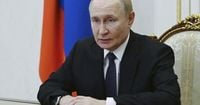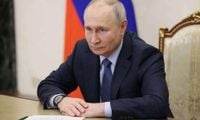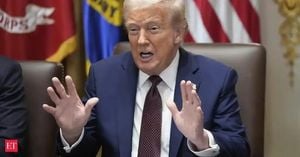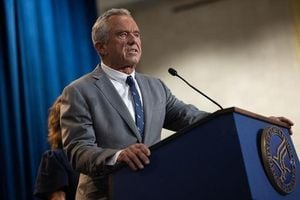Russian President Vladimir Putin is set to make a landmark visit to India in December 2025, the Kremlin confirmed on Friday, marking a significant moment in the evolving relationship between Moscow and New Delhi. This trip, which comes at a time of mounting Western sanctions and diplomatic pressure, underscores the deepening ties between the two nations—ties that have roots stretching back to the Cold War era and have only grown more complex in recent years.
Before the December visit, Putin will meet Indian Prime Minister Narendra Modi on Monday, September 1, 2025, on the sidelines of the Shanghai Cooperation Organization (SCO) Summit in Tianjin, China. According to Kremlin foreign policy aide Yuri Ushakov, the two leaders will use this meeting to discuss preparations for Putin’s official visit to India. Ushakov told reporters, “Right after the SCO Plus meeting (on September 1), our president will meet Indian Prime Minister Modi. Preparations will be discussed for the visit of our president to India in December.”
The SCO Summit itself is a major diplomatic event, bringing together leaders from across Eurasia to discuss security, economic cooperation, and regional stability. Putin’s visit to China, which spans from August 31 to September 3, includes not only the meeting with Modi but also bilateral talks with Chinese President Xi Jinping, Turkish President Recep Tayyip Erdogan, Iranian President Masoud Pezeshkian, and potentially North Korean leader Kim Jong Un. Putin is also scheduled to attend a massive military parade in Beijing commemorating the 80th anniversary of the end of World War II, according to the Kremlin.
This upcoming engagement between Putin and Modi will be their first in-person meeting of the year, although the two leaders have maintained regular contact by phone. Their discussions are expected to focus on both the logistics of the December visit and broader strategic issues. As Ushakov noted, “Our countries are bound by a special strategic partnership,” referencing a statement passed in December 2010. That means 2025 marks the 15th anniversary of this partnership, lending additional significance to Putin’s trip.
Prime Minister Modi, for his part, has been an active participant in high-level diplomacy with Russia. In 2024, he traveled to Russia twice—first to Moscow in July for direct talks with Putin, and then to Kazan in October to attend the BRICS Summit. These visits, which took place after Russia’s full-scale invasion of Ukraine in 2022, signaled India’s intention to maintain robust ties with Moscow despite international pressure. According to The Associated Press, “Modi has avoided condemning Russia while emphasizing a peaceful settlement.”
The context for Putin’s visit is shaped by a rapidly shifting geopolitical landscape. The United States, under President Donald Trump, has recently doubled tariffs on Indian goods to 50 percent, including an additional 25 percent duty specifically targeting India’s purchase of Russian crude oil. This move is part of Washington’s broader campaign to cut Moscow’s revenues and pressure Russia to end its ongoing war in Ukraine. As reported by AFP and other outlets, the US tariffs are a direct response to New Delhi’s large-scale purchases of Russian oil—a trade that has become even more vital for Moscow as Western sanctions have cut off access to traditional European markets.
India, however, has pushed back against US pressure. Government officials have emphasized that their energy procurement is driven by national interests and market dynamics. As one administrative source explained, “India imported oil from Russia because traditional supplies were diverted to Europe after the outbreak of the conflict.” This pragmatic approach has allowed India to secure favorable energy deals while supporting its growing economy, even as it navigates the diplomatic fallout with Washington.
The economic stakes are high for both countries. Russia remains one of India’s top arms suppliers, and their defense relationship is a cornerstone of the broader partnership. As noted by several sources, these ties date back to the Soviet era, and Moscow continues to provide advanced military hardware and technology to New Delhi. Meanwhile, Russia’s ability to redirect energy exports from Europe to Asia—especially to India and China—has helped ensure the continued flow of multi-billion-dollar revenues into its state budget, even as Western allies seek to cut off these earnings.
The legal and political dimensions of the US tariffs have added another layer of complexity. In a significant development, the US Federal Circuit Court recently ruled that most of President Trump’s tariffs are illegal, finding that he exceeded his authority under the International Emergency Economic Powers Act (IEEPA). The court determined that the power to levy tariffs is a core right of the US Congress. Despite this ruling, the tariffs remain in effect while the case is appealed to the Supreme Court. President Trump has vowed to fight the decision, warning that “tariff removal will destroy America.” The outcome of this legal battle could have major implications for US-India trade and the broader global economy.
For Russia, the December visit is also notable because Putin has significantly curtailed his foreign travel since the International Criminal Court (ICC) issued an arrest warrant against him over the Ukraine conflict. India, however, is not a party to the ICC and is therefore not obligated to detain the Russian leader. This legal technicality allows for continued high-level engagement between Moscow and New Delhi, even as Western capitals shun direct contact with Putin.
India’s balancing act—maintaining strategic partnerships with both Russia and the West—has become increasingly delicate. While New Delhi has refrained from condemning Russia’s actions in Ukraine, it has also called for a peaceful resolution to the conflict. At the same time, India has sought to deepen ties with other major powers, including Japan. Just recently, Prime Minister Modi traveled with Japanese Prime Minister Shigeru Ishiba on a high-speed bullet train in Japan, with the agenda focused on technology transfer and bilateral cooperation in sectors like rail and semiconductors.
All eyes will be on the upcoming meetings in China and the December summit in India. As Russia and India mark the 15th anniversary of their special strategic partnership, both nations are signaling their intent to deepen cooperation in the face of shifting global alliances and mounting external pressures. The diplomatic choreography unfolding between Moscow, New Delhi, Beijing, and Washington offers a vivid illustration of how the world’s major powers are recalibrating their relationships in a time of uncertainty and change.
With the stakes rising and the world watching, the outcomes of these high-level engagements could shape the regional and global order for years to come.






